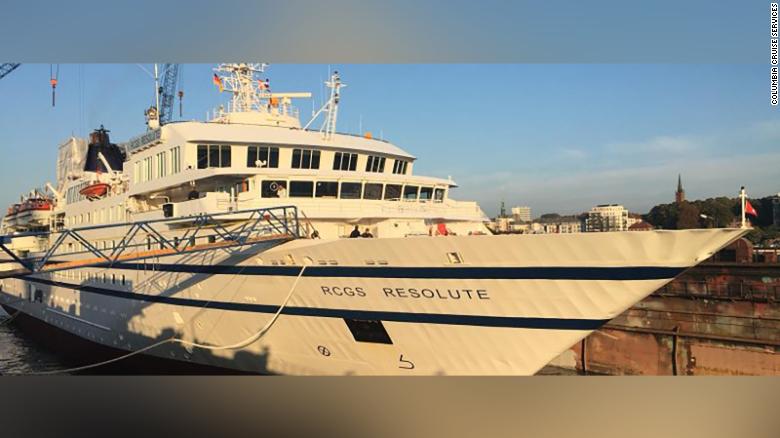Re: CQ's Military thread
Posted: Fri Apr 03, 2020 4:55 pm
Did the Navy do a facebook poll or set up a committee of soccer mom's to decide if this was fair treatment for the captain?
UJ's Hamster Died. We're All That's Left...
https://ujrefugees.net/


"I’m going to surround myself only with the best and most serious people. We want top of the line professionals."

Yeah, after actually traveling overseas in order to berate a captain to his men, he had to go. That wasn't in any way acceptable behavior.Stapes wrote: ↑Tue Apr 07, 2020 7:52 pm Acting Secretary of the Navy has submitted his resignation
https://www.cnn.com/2020/04/07/politics ... index.html
the funny thing is hearing him say "...... if he didn't think that in this day in age that would be leaked out then he's too stupid...."FSchmertz wrote: ↑Tue Apr 07, 2020 8:09 pmYeah, after actually traveling overseas in order to berate a captain to his men, he had to go. That wasn't in any way acceptable behavior.Stapes wrote: ↑Tue Apr 07, 2020 7:52 pm Acting Secretary of the Navy has submitted his resignation
https://www.cnn.com/2020/04/07/politics ... index.html


I wonder how many people got that
Underrated?! That would be like underrating Jack Bruce or John Enwhistle or Chris Squire or Stanley Clarke or ...

Just a bunch of failures for letting a plane drop bombs on them.CaptQuint wrote: ↑Mon Apr 27, 2020 10:40 pm On March 19, 1945, USS Franklin (CV-13) was barely fifty miles from the coast of Kyūshū, southernmost of the Japanese home islands. Along with another 20 assorted carriers of Task Force 58, Franklin’s task that day was to launch air strikes against the great Imperial Naval Base at Kure. A fighter sweep and one bombing mission had already been sent out when, shortly after 0700hrs, a Japanese bomber broke through low clouds and bore straight for Franklin. While the carrier had already been the victim of a kamikaze attack in October, this plane did not make a suicide run. Instead it quickly dropped two 550-pound bombs and then disappeared back into the clouds.
The damage was immediate and severe. Both bombs penetrated the flight deck and exploded in the hangar bay spaces below. Almost all sailors working on planes in the hangar were killed. The forward and aft aircraft elevators were blasted off their tracks. Even worse was the fact that there were 31 fully fueled and armed aircraft waiting on Franklin’s flight deck. Altogether these possessed an estimated 17,000 gallons of aviation gasoline and over 38,000 pounds of ordinance. Franklin was soon wreathed in fire and explosions that sent a column of thick black smoke tumbling hundreds of feet into the sky.
The next few hours saw one of the most incredible feats of damage control in the history of the U.S. Navy. Despite the horrific damage and casualties, Franklin’s crew fought desperately to save their ship. As the engine rooms became untenable from smoke, the ship lost all power and went dead in the water. The light cruiser USS Santa Fe (CL-60) pulled along the starboard side to take off wounded and ply its own fire hoses on the blaze. Due to the huge amounts of water pumped in to fight the fires, Franklin took on a heavy starboard list. Destroyers USS Miller (DD-535) and USS Hickox (DD-673) stood by to rescue sailors who had been blown or jumped into the water. By 1000hrs the heavy cruiser USS Pittsburgh (CA-72) had connected a towing line to Franklin’s bow and began the task of getting the carrier out of the combat area. Throughout the day the fires were gradually taken under control and extinguished.
The crew of the Franklin had saved their ship, but paid an extremely high price. In all, 796 men had been killed and 265 wounded. But for their heroic efforts, Franklin’s crew earned a combined 347 Purple Hearts (plus an additional 808 awarded posthumously), 235 Letters of Commendation, 116 Bronze Stars, 22 Silver Stars, 19 Navy Crosses and 2 Medals of Honor. The Medals of Honor were awarded to Lt. (j.g.) Donald A. Gary and Lt. Cmdr. Joseph T. O’Callahan. Gary had used breathing devices to rescue close to 300 sailors from smoke-filled compartments, assisted in battling fires on the hangar deck, and helped restore steam to one of the boilers. O’Callahan was Franklin’s Roman Catholic chaplain, and was seeming everywhere on the ship. The white cross on his helmet served as a symbol of inspiration to fellow crewmen as he delivered last rites to dying sailors, handled fire hoses and jettisoned live ordinance. After Franklin reached the safety of Ulithi Atoll on March 24, O’Callahan lead funeral services in the burnt out hangar.
This photo shows Franklin just over one month after that terrible March day, steaming under her own power up the Hudson River towards New York City. Her destination is the Brooklyn Navy Yard, which is just beyond the Brooklyn and Manhattan Bridges at right. Damage is clearly visible all around. The wooden flight deck is almost completely burned away. The metal underneath is bent from the heat of the fires and holed by explosions from bombs on parked aircraft. A portion of the aft elevator is sticking up at left. Also absent are any radar masts above the bridge. Wrecked by the force of explosions, these had been cut away at Ulithi. Franklin would spend over a year under repair. The flight deck and gallery deck spaces were so throughly wrecked that they were completely rebuilt. On October 13, 1945, victorious warships of the U.S. Navy packed the Hudson River to celebrate Navy Day. Franklin would also be open to visitors, and thousands of people saw the ship in Brooklyn. The carrier would never see combat again, though. When repairs officially completed on June 15, 1946, Franklin reported to the Atlantic Reserve Fleet and was placed out of commission in February 1947. The proud ship was eventually sold for scrap on August 1, 1966.
lolB-Tender wrote: ↑Mon Apr 27, 2020 10:52 pmJust a bunch of failures for letting a plane drop bombs on them.CaptQuint wrote: ↑Mon Apr 27, 2020 10:40 pm On March 19, 1945, USS Franklin (CV-13) was barely fifty miles from the coast of Kyūshū, southernmost of the Japanese home islands. Along with another 20 assorted carriers of Task Force 58, Franklin’s task that day was to launch air strikes against the great Imperial Naval Base at Kure. A fighter sweep and one bombing mission had already been sent out when, shortly after 0700hrs, a Japanese bomber broke through low clouds and bore straight for Franklin. While the carrier had already been the victim of a kamikaze attack in October, this plane did not make a suicide run. Instead it quickly dropped two 550-pound bombs and then disappeared back into the clouds.
The damage was immediate and severe. Both bombs penetrated the flight deck and exploded in the hangar bay spaces below. Almost all sailors working on planes in the hangar were killed. The forward and aft aircraft elevators were blasted off their tracks. Even worse was the fact that there were 31 fully fueled and armed aircraft waiting on Franklin’s flight deck. Altogether these possessed an estimated 17,000 gallons of aviation gasoline and over 38,000 pounds of ordinance. Franklin was soon wreathed in fire and explosions that sent a column of thick black smoke tumbling hundreds of feet into the sky.
The next few hours saw one of the most incredible feats of damage control in the history of the U.S. Navy. Despite the horrific damage and casualties, Franklin’s crew fought desperately to save their ship. As the engine rooms became untenable from smoke, the ship lost all power and went dead in the water. The light cruiser USS Santa Fe (CL-60) pulled along the starboard side to take off wounded and ply its own fire hoses on the blaze. Due to the huge amounts of water pumped in to fight the fires, Franklin took on a heavy starboard list. Destroyers USS Miller (DD-535) and USS Hickox (DD-673) stood by to rescue sailors who had been blown or jumped into the water. By 1000hrs the heavy cruiser USS Pittsburgh (CA-72) had connected a towing line to Franklin’s bow and began the task of getting the carrier out of the combat area. Throughout the day the fires were gradually taken under control and extinguished.
The crew of the Franklin had saved their ship, but paid an extremely high price. In all, 796 men had been killed and 265 wounded. But for their heroic efforts, Franklin’s crew earned a combined 347 Purple Hearts (plus an additional 808 awarded posthumously), 235 Letters of Commendation, 116 Bronze Stars, 22 Silver Stars, 19 Navy Crosses and 2 Medals of Honor. The Medals of Honor were awarded to Lt. (j.g.) Donald A. Gary and Lt. Cmdr. Joseph T. O’Callahan. Gary had used breathing devices to rescue close to 300 sailors from smoke-filled compartments, assisted in battling fires on the hangar deck, and helped restore steam to one of the boilers. O’Callahan was Franklin’s Roman Catholic chaplain, and was seeming everywhere on the ship. The white cross on his helmet served as a symbol of inspiration to fellow crewmen as he delivered last rites to dying sailors, handled fire hoses and jettisoned live ordinance. After Franklin reached the safety of Ulithi Atoll on March 24, O’Callahan lead funeral services in the burnt out hangar.
This photo shows Franklin just over one month after that terrible March day, steaming under her own power up the Hudson River towards New York City. Her destination is the Brooklyn Navy Yard, which is just beyond the Brooklyn and Manhattan Bridges at right. Damage is clearly visible all around. The wooden flight deck is almost completely burned away. The metal underneath is bent from the heat of the fires and holed by explosions from bombs on parked aircraft. A portion of the aft elevator is sticking up at left. Also absent are any radar masts above the bridge. Wrecked by the force of explosions, these had been cut away at Ulithi. Franklin would spend over a year under repair. The flight deck and gallery deck spaces were so throughly wrecked that they were completely rebuilt. On October 13, 1945, victorious warships of the U.S. Navy packed the Hudson River to celebrate Navy Day. Franklin would also be open to visitors, and thousands of people saw the ship in Brooklyn. The carrier would never see combat again, though. When repairs officially completed on June 15, 1946, Franklin reported to the Atlantic Reserve Fleet and was placed out of commission in February 1947. The proud ship was eventually sold for scrap on August 1, 1966.